- Home
- H. Rider Haggard
King Solomon's Mines (Barnes & Noble Classics Series) Page 22
King Solomon's Mines (Barnes & Noble Classics Series) Read online
Page 22
Chapter 16
The Place of Death
IT WAS ALREADY DARK on the third day after the scene described in the previous chapter, when we camped in some huts at the foot of the “Three Witches,” as the triangle of mountains were called to which Solomon’s great road ran. Our party consisted of our three selves and Foulata, who waited on us—especially on Good—Infadoos, Gagool, who was borne along in a litter, inside which she could be heard muttering and cursing all day long, and a party of guards and attendants. The mountains, or rather the three peaks of the mountains, for the whole mass evidently consisted of a solitary upheaval, were, as I have said, in the form of a triangle, of which the base was towards us, one peak being on our right, one on our left, and one straight in front of us. Never shall I forget the sight afforded by those three towering peaks in the early sunlight of the following morning. High, high above us, up into the blue air, soared their twisted snow-wreaths. Beneath the snow the peaks were purple with heaths, and so were the wild moors that ran up the slopes towards them. Straight before us the white ribbon of Solomon’s great road stretched away uphill to the foot of the centre peak, about five miles from us, and there stopped. It was its terminus.
I had better leave the feelings of intense excitement with which we set out on our march that morning to the imagination of those who read this history. At last we were drawing near to the wonderful mines that had been the cause of the miserable death of the old Portuguese Dom, three centuries ago, of my poor friend, his illstarred descendant, and also, as we feared, of George Curtis, Sir Henry’s brother. Were we destined, after all that we had gone through, to fare any better? Evil befell them, as that old fiend Gagool said, would it also befall us? Somehow, as we were marching up that last stretch of beautiful road, I could not help feeling a little superstitious about the matter, and so I think did Good and Sir Henry.
For an hour and a half or more we tramped on up the heather-fringed road, going so fast in our excitement that the bearers with Gagool’s hammock could scarcely keep pace with us, and its occupant piped out to us to stop.
“Go more slowly, white men,” she said, projecting her hideous shrivelled countenance between the curtains, and fixing her gleaming eyes upon us; “why will ye run to meet the evil that shall befall ye, ye seekers after treasure?” and she laughed that horrible laugh which always sent a cold shiver down my back, and which for awhile quite took the enthusiasm out of us.
However, on we went, till we saw before us, and between ourselves and the peak, a vast circular hole with sloping sides, three hundred feet or more in depth, and quite half a mile round.
“Can’t you guess what this is?” I said to Sir Henry and Good, who were staring in astonishment down into the awful pit before us.
They shook their heads.
“Then it is clear that you have never seen the diamond mines at Kimberley. You may depend on it that this is Solomon’s Diamond Mine; look there,” I said, pointing to the stiff blue clay which was yet to be seen among the grass and bushes which clothed the sides of the pit, “the formation is the same. I’ll be bound that if we went down there we should find ‘pipes’ of soapy brecciated rock. Look, too,” and I pointed to a series of worn flat slabs of rock which were placed on a gentle slope below the level of a watercourse which had in some past age been cut out of the solid rock; “if those are not tables once used to wash the ‘stuff,’ I’m a Dutchman.”
At the edge of this vast hole, which was the pit marked on the old Don’s map, the great road branched into two and circumvented it. In many places this circumventing road was built entirely of vast blocks of stone, apparently with the object of supporting the edges of the pit and preventing falls of reef. Along this road we pressed, driven by curiosity to see what the three towering objects were which we could discern from the hither side of the great hole. As we got nearer we perceived that they were colossi of some sort or another, and rightly conjectured that these were the three “Silent Ones” that were held in such awe by the Kukuana people. But it was not until we got quite close that we recognised the full majesty of these “Silent Ones.”
There upon huge pedestals of dark rock, sculptured in unknown characters, twenty paces between each, and looking down the road which crossed some sixty miles of plain to Loo, were three colossal seated forms—two males and one female—each measuring about twenty feet from the crown of the head to the pedestal.
The female form, which was nude, was of great though severe beauty, but unfortunately the features were injured by centuries of exposure to the weather. Rising from each side of her head were the points of a crescent. The two male colossi were, on the contrary, draped, and presented a terrifying cast of features, especially the one to our right, which had the face of a devil. That to our left was serene in countenance, but the calm upon it was dreadful. It was the calm of inhuman cruelty, the cruelty, Sir Henry remarked, that the ancients attributed to beings potent for good, who could yet watch the sufferings of humanity, if not with rejoicing, at least without suffering themselves. The three formed a most awe-inspiring trinity, as they sat there in their solitude and gazed out across the plain for ever. Contemplating these “Silent Ones,” as the Kukuanas called them, an intense curiosity again seized us to know whose were the hands that had shaped them, who was it that had dug the pit and made the road. Whilst I was gazing and wondering, it suddenly occurred to me (being familiar with the Old Testament) that Solomon went astray after strange gods, the names of three of whom I remembered—“ Ashtoreth the goddess of the Zidonians, Chemosh the god of the Moabites, and Milcom the god of the children of Ammon”—and I suggested to my companions that the three figures before us might represent these false divinities.
“Hum,” said Sir Henry, who was a scholar, having taken a high degree in classics at college, “there may be something in that; Ashtoreth of the Hebrews was the Astarte of the Phoenicians, who were the great traders of Solomon’s time. Astarte, who afterwards was the Aphrodite of the Greeks, was represented with horns like the half-moon, and there on the brow of the female figure are distinct horns. Perhaps these colossi were designed by some Phoenician official who managed the mines. Who can say?”
Before we had finished examining these extraordinary relics of remote antiquity, Infadoos came up, and, having saluted the “Silent Ones” by lifting his spear, asked us if we intended entering the “Place of Death” at once, or if we would wait till after we had taken food at mid-day. If we were ready to go at once, Gagool had announced her willingness to guide us. As it was not more than eleven o’clock, we—driven to it by a burning curiosity—announced our intention of proceeding instantly, and I suggested that, in case we should be detained in the cave, we should take some food with us. Accordingly Gagool’s litter was brought up, and that lady herself assisted out of it; and meanwhile Foulata, at my request, stored some “biltong,” or dried game-flesh, together with a couple of gourds of water in a reed basket. Straight in front of us, at a distance of some fifty paces from the backs of the colossi, rose a sheer wall of rock, eighty feet or more in height, that gradually sloped up till it formed the base of the lofty snow-wreathed peak, which soared up into the air three thousand feet above us. As soon as she was clear of her hammock, Gagool cast one evil grin upon us, and then, leaning on a stick, hobbled off towards the sheer face of the rock. We followed her till we came to a narrow portal solidly arched, that looked like the opening of a gallery of a mine.
Here Gagool was waiting for us, still with that evil grin upon her horrid face.
“Now, white men from the stars,” she piped; “great warriors, Incubu, Bougwan, and Macumazahn the wise, are ye ready? Behold, I am here to do the bidding of my lord the king, and to show ye the store of bright stones.”
“We are ready,” I said.
“Good! good! Make strong your hearts to bear what ye shall see. Comest thou too, Infadoos, who didst betray thy master?”
Infadoos frowned as he answered—
“Nay, I come n
ot, it is not for me to enter there. But thou, Gagool, curb thy tongue, and beware how thou dealest with my lords. At thy hands will I require them, and if a hair of them be hurt, Gagool, be’st thou fifty times a witch, thou shalt die. Hearest thou?”
“I hear, Infadoos; I know thee, thou didst ever love big words; when thou wast a babe I remember thou didst threaten thine own mother. That was but the other day. But fear not, fear not, I live but to do the bidding of the king. I have done the bidding of many kings, Infadoos, till in the end they did mine. Ha! ha! I go to look upon their faces once more, and Twala’s too! Come on, come on, here is the lamp,” and she drew a great gourd full of oil, and fitted with a rush wick, from under her fur cloak.
“Art thou coming, Foulata?” asked Good in his villainous Kitchen Kukuana, in which he had been improving himself under that young lady’s tuition.
“I fear, my lord,” the girl answered, timidly.
“Then give me the basket.”
“Nay, my lord, whither thou goest, there will I go also.”
“The deuce you will!” thought I to myself; “that will be rather awkward if ever we get out of this.”
Without further ado Gagool plunged into the passage, which was wide enough to admit of two walking abreast, and quite dark, we following her voice as she piped to us to come on, in some fear and trembling, which was not allayed by the sound of a sudden rush of wings.
“Hullo! what’s that?” halloed Good; “somebody hit me in the face.”
“Bats,” said I; “on you go.”
When we had, so far as we could judge, gone some fifty paces, we perceived that the passage was growing faintly light. Another minute, and we stood in the most wonderful place that the eyes of living man ever lit on.
Let the reader picture to himself the hall of the vastest cathedral he ever stood in, windowless indeed, but dimly lighted from above (presumably by shafts connected with the outer air and driven in the roof, which arched away a hundred feet above our head), and he will get some idea of the size of the enormous cave in which we stood, with the difference that this cathedral designed of nature was loftier and wider than any built by man. But its stupendous size was the least of the wonders of the place, for running in rows down its length were gigantic pillars of what looked like ice, but were, in reality, huge stalactites. It is impossible for me to convey any idea of the overpowering beauty and grandeur of these pillars of white spar, some of which were not less than twenty feet in diameter at the base, and sprang up in lofty and yet delicate beauty sheer to the distant roof. Others again were in process of formation. On the rock floor there was in these cases what looked, Sir Henry said, exactly like a broken column in an old Grecian temple, whilst high above, depending from the roof, the point of a huge icicle could be dimly seen. And even as we gazed we could hear the process going on, for presently with a tiny splash a drop of water would fall from the far-off icicle on to the column below. On some columns the drops only fell once in two or three minutes, and in these cases it would form an interesting calculation to discover how long, at that rate of dripping, it would take to form a pillar, say eighty feet high by ten in diameter. That the process was, in at least one instance, incalculably slow, the following instance will suffice to show. Cut on one of these pillars we discovered a rude likeness of a mummy, by the head of which sat what appeared to be one of the Egyptian gods, doubtless the handiwork of some old-world labourer in the mine. This work of art was executed at about the natural height at which an idle fellow, be he Phoenician workman or British cad, is in the habit of trying to immortalise himself at the expense of nature’s masterpieces, namely, about five feet from the ground; yet at the time that we saw it, which must have been nearly three thousand years after the date of the execution of the drawing, the column was only eight feet high, and was still in process of formation, which gives a rate of growth of a foot to a thousand years, or an inch and a fraction to a century. This we knew because, as we were standing by it, we heard a drop of water fall.
Sometimes the stalactites took strange forms, presumably where the dropping of the water had not always been on the same spot. Thus, one huge mass, which must have weighed a hundred tons or so, was in the form of a pulpit, beautifully fretted over outside with what looked like lace. Others resembled strange beasts, and on the sides of the cave were fan-like ivory tracings, such as the frost leaves upon a pane.
Out of the vast main aisle, there opened here and there smaller caves, exactly, Sir Henry said, as chapels open out of great cathedrals. Some were large, but one or two—and this is a wonderful instance of how nature carries out her handiwork by the same unvarying laws, utterly irrespective of size—were tiny. One little nook, for instance, was no larger than an unusually big doll’s house, and yet it might have been the model of the whole place, for the water dropped, the tiny icicles hung, and the spar columns were forming in just the same way.
We had not, however, as much time to examine this beautiful place as thoroughly as we should have liked to do, for unfortunately Gagool seemed to be indifferent to stalactites, and only anxious to get her business over. This annoyed me the more, as I was particularly anxious to discover, if possible, by what system the light was admitted into the place, and whether it was by the hand of man or of nature that this was done, also if it had been used in any way in ancient times, as seemed probable. However, we consoled ourselves with the idea that we would examine it thoroughly on our return, and followed on after our uncanny guide.
On she led us, straight to the top of the vast and silent cave, where we found another doorway, not arched as the first was, but square at the top, something like the doorways of Egyptian temples.
“Are ye prepared to enter the Place of Death?” asked Gagool, evidently with a view to making us feel uncomfortable.
“Lead on, Macduff,”1 said Good, solemnly, trying to look as though he was not at all alarmed, as indeed did we all except Foulata, who caught Good by the arm for protection.
“This is getting rather ghastly,” said Sir Henry, peeping into the dark doorway. “Come on, Quatermain—seniores priores.ap Don’t keep the old lady waiting!” and he politely made way for me to lead the van, for which I inwardly did not bless him.
Tap, tap, went old Gagool’s stick down the passage, as she trotted along, chuckling hideously; and still overcome by some unaccountable presentiment of evil, I hung back.
“Come, get on, old fellow,” said Good, “or we shall lose our fair guide.”
Thus adjured, I started down the passage, and after about twenty paces found myself in a gloomy apartment some forty feet long, by thirty broad, and thirty high, which in some past age had evidently been hollowed, by hand-labour, out of the mountain. This apartment was not nearly so well lighted as the vast stalactite ante-cave, and at the first glance all I could make out was a massive stone table running its length, with a colossal white figure at its head, and life-sized white figures all round it. Next I made out a brown thing, seated on the table in the centre, and in another moment my eyes grew accustomed to the light, and I saw what all these things were, and I was tailing out of it as hard as my legs would carry me. I am not a nervous man, in a general way, and very little troubled with superstitions, of which I have lived to see the folly; but I am free to own that that sight quite upset me, and had it not been that Sir Henry caught me by the collar and held me, I do honestly believe that in another five minutes I should have been outside that stalactite cave, and that the promise of all the diamonds in Kimberley would not have induced me to enter it again. But he held me tight, so I stopped because I could not help myself. But next second his eyes got accustomed to the light, too, and he let go of me, and began to mop the perspiration off his forehead. As for Good he swore feebly, and Foulata threw her arms round his neck and shrieked.
Only Gagool chuckled loud and long.
It was a ghastly sight. There at the end of the long stone table, holding in his skeleton fingers a great white spear, sat Death himself, shaped in
the form of a colossal human skeleton, fifteen feet or more in height. High above his head he held the spear, as though in the act to strike; one bony hand rested on the stone table before him, in the position a man assumes on rising from his seat, whilst his frame was bent forward so that the vertebrae of the neck and the grinning, gleaming skull projected towards us, and fixed its hollow eye-places upon us, the jaws a little open, as though it were about to speak.
“Great heavens!” said I, faintly, at last, “what can it be?”
“And what are those things?” said Good, pointing to the white company round the table.
“And what on earth is that thing?” said Sir Henry, pointing to the brown creature seated on the table.
“Hee! hee! hee!” laughed Gagool. “To those who enter the Hall of the Dead, evil comes. Hee! hee! hee! ha! ha!”
“Come, Incubu, brave in battle, come and see him thou slewest;” and the old creature caught his coat in her skinny fingers, and led him away towards the table. We followed.
Presently she stopped and pointed at the brown object seated on the table. Sir Henry looked, and started back with an exclamation; and no wonder, for there seated, quite naked, on the table, the head which Sir Henry’s battle-axe had shorn from the body resting on its knees, was the gaunt corpse of Twala, last king of the Kukuanas. Yes, there, the head perched upon the knees, it sat in all its ugliness, the vertebræ projecting a full inch above the level of the shrunken flesh of the neck, for all the world like a black double of Hamilton Tighe. aq2 Over the whole surface of the corpse there was gathered a thin, glassy film, which made its appearance yet more appalling, and for which we were, at the moment, quite unable to account, till we presently observed that from the roof of the chamber the water fell steadily, drip! drop! drip! on to the neck of the corpse, from whence it ran down over the entire surface, and finally escaped into the rock through a tiny hole in the table. Then I guessed what it was—Twala’s body was being transformed into a stalactite.

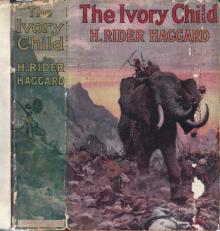 The Ivory Child
The Ivory Child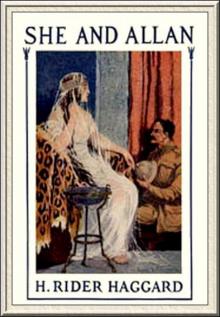 She and Allan
She and Allan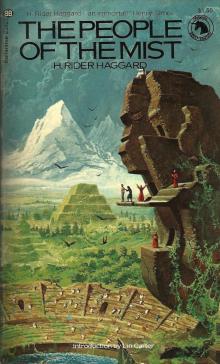 The People of the Mist
The People of the Mist She
She Morning Star
Morning Star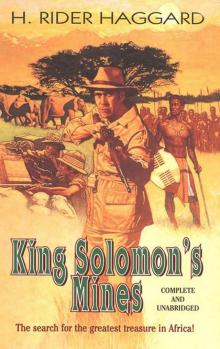 King Solomon's Mines
King Solomon's Mines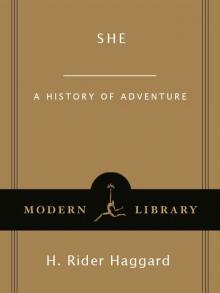 She: A History of Adventure
She: A History of Adventure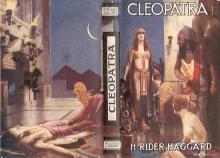 Cleopatra
Cleopatra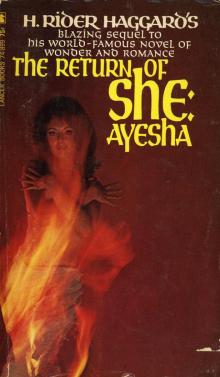 Ayesha, the Return of She
Ayesha, the Return of She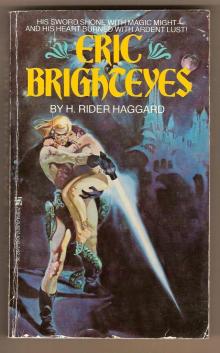 Eric Brighteyes
Eric Brighteyes Red Eve
Red Eve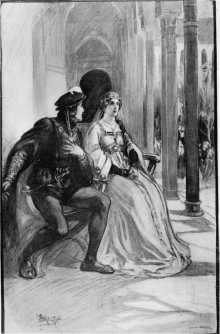 Fair Margaret
Fair Margaret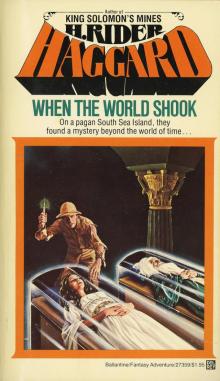 When the World Shook
When the World Shook Lysbeth, a Tale of the Dutch
Lysbeth, a Tale of the Dutch Moon of Israel: A Tale of the Exodus
Moon of Israel: A Tale of the Exodus Long Odds
Long Odds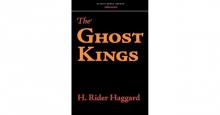 The Ghost Kings
The Ghost Kings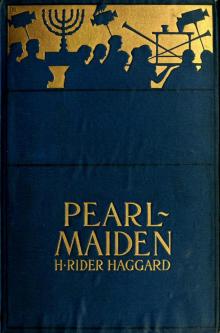 Pearl-Maiden: A Tale of the Fall of Jerusalem
Pearl-Maiden: A Tale of the Fall of Jerusalem Allan and the Holy Flower
Allan and the Holy Flower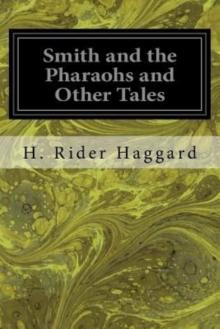 Smith and the Pharaohs, and other Tales
Smith and the Pharaohs, and other Tales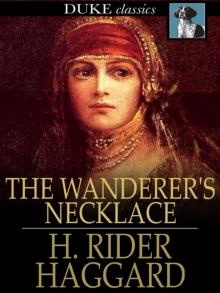 The Wanderer's Necklace
The Wanderer's Necklace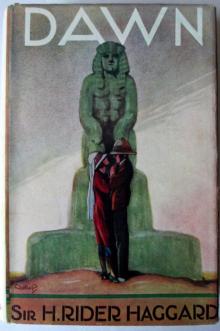 Dawn
Dawn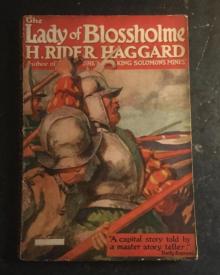 The Lady of Blossholme
The Lady of Blossholme Stella Fregelius: A Tale of Three Destinies
Stella Fregelius: A Tale of Three Destinies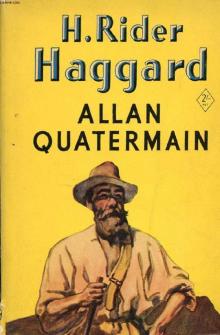 Allan Quatermain
Allan Quatermain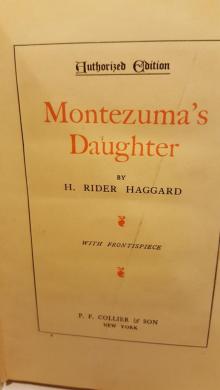 Montezuma's Daughter
Montezuma's Daughter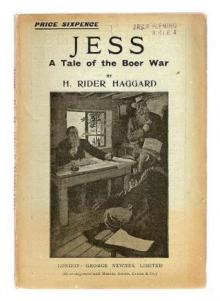 Jess
Jess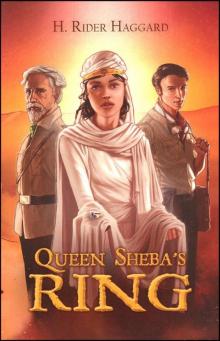 The Brethren
The Brethren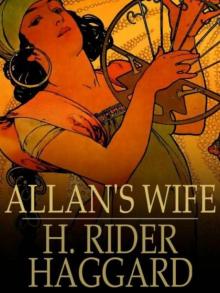 Allan's Wife
Allan's Wife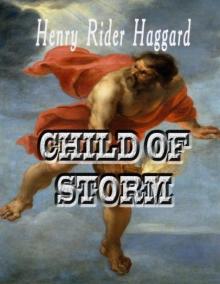 Child of Storm
Child of Storm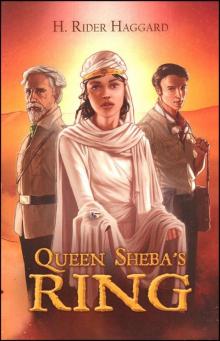 Queen Sheba's Ring
Queen Sheba's Ring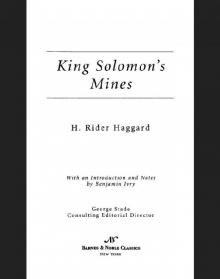 King Solomon's Mines (Barnes & Noble Classics Series)
King Solomon's Mines (Barnes & Noble Classics Series)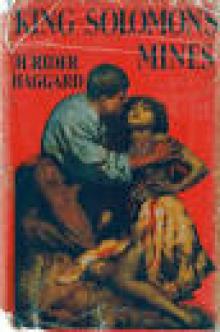 Complete Allan Quatermain Omnibus - Volumes 1 - 10
Complete Allan Quatermain Omnibus - Volumes 1 - 10